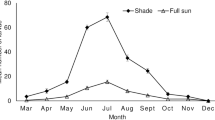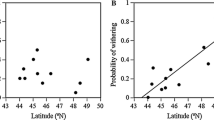Abstract
The interactions between Persea borbonia (redbay), its psyllid leaf gallers, and its seed predators were examined in field conditions using natural differences in light levels in order to determine (a) the distribution of galls relative to light availability, (b) the relationship between galls and plant growth and reproductive traits and (c) the relationship between gallers and seed predators. Galls were more abundant in shade than sun across sites. This finding is consistent with the Sink Competition Hypothesis, which predicts higher gall loads on plants with longer internodes (as those in shade) and hence less competition among sinks. Galled leaves were smaller and senesced more rapidly, and galled shoots grew less. In the sun, galled branches produced fewer flowers, but there was ultimately no relationship between gall load and seed production in the year sampled. Gall load was not correlated with seed predation in sun or shade, suggesting no indirect interactions between herbivores. This work suggests that gall insects negatively affect plant growth and reproduction, but manipulative experiments must be conducted to confirm this. Additionally, this study suggests that relationships between leaf gall load and plant fitness traits may not be clearly regulated by the availability of sunlight resources to the plant.
Similar content being viewed by others
References
Abrahamson W.G., McCrea K.D. (1986) Nutrient and biomass allocation in Solidago altissima: effects of two stem gallmakers, fertilization, and ramet isolation. Oecologia 68: 174–180
Burns R.M. and Honkala B.H. 1990. Silvics of North America: Volume II: Hardwoods. United States Department of Agriculture. Forest Service. Agriculture Handbook 654 pp
Collinge S.K., Louda S.M. (1988) Herbivory by leaf miners in response to experimental shading of a native crucifer. Oecologia 75: 559–566
Crawley M.J. (1983) Herbivory. The Dynamics of Animal-Plant Interactions. Blackwell Scientific Publications, Oxford, UK
Denno R.F., McClure M.S., Ott J.R. (1995) Interspecific interactions in phytophagous insects: Competition reexamined and resurrected. Annual Review of Entomology 40: 297–331
Denno R.F., Peterson M.A., Gratton C., Cheng J.A., Langellotto G.A., Huberty A.F., Finke D.O.L. (2000) Feeding-induced changes in plant quality mediate interspecific competition between sap-feeding herbivores. Ecology 81: 1814–1827
Dixon A.F.G. (1971) The role of aphids in wood formation I. The effect of the sycamore aphid, Drepanosiphum platanoidis (Schr.) (Aphididae), on the growth of sycamore, Acer pseudoplatanus (L.). Journal of Applied Ecology 8: 165–79
Dixon R.K. (1990) Physiological processes and tree growth. In: Dixon R.D., Ruark G.A., Warren W.G. (eds) Forest Growth: Process Modeling of Forest Growth Responses to Environmental Stress. Timber Press, Portland, Oregon, pp. 21–32
Dudt J.F., Shure D.J. (1994) The influence of light and nutrients on foliar phenolics and insect herbivory. Ecology 7: 86–98
Ellison A.M. (1987) Effects of competition, disturbance, and herbivory on Salicornia europaea. Ecology 68: 576–586
Faeth S.H., Connor E.F., Simberloff D. (1981) Early leaf abscission: a neglected source of mortality for folivores. American Naturalist 117: 409–415
Fay P.A., Hartnett D.C., Knapp A.K. (1996) Plant tolerance of gall-insect attack and gall-insect performance. Ecology 77: 521–534
Fay P.A., Preszler R.W., Whitham T.G. (1996) The functional resource of a gall-forming adelgid. Oecologia 105: 199–204
Georgia Weather Automated Environmental Monitoring Network Page. http://www.griffin.peachnet.edu/bae/
Gradwell G. (1974) The effect of defoliators on tree growth. In: Morris M.G., Perring F.H. (eds) The British Oaks. Classey, Farringdon, UK, pp. 182–193
Hartnett D.C., Abrahamson W.G. (1979) The effects of stem gall insects on life history patterns in Solidago canadensis. Ecology 60: 910–917
Haukioja E., Ruohomäki K., Senn J., Suomela J., Walls M. (1990) Consequences of herbivory in the mountain birch (Betula pubescens spp tortuosa): importance of the functional organization of the tree. Oecologia 82: 238–247
Hodkinson I.D. (1984) The biology and ecology of the gall-forming Psylloidea (Homoptera). In: Anathakrishnan T.N. (eds) Biology of Gall Insects. Edward Arnold, London, pp. 59–77
Hollis D., Martin J.H. (1997) Jumping plantlice (Hemiptera: Psylloidea) attacking avocado pear trees, Persea americana, in the New World, with a review of Lauraceae-feeding among psylloids. Bulletin of Entomological Research 87: 471–480
Inbar M., Eshel A., Wool D. (1995) Interspecific competition among phloem-feeding insects mediated by induced host-plant sinks. Ecology 76: 1506–1515
Karban R., Strauss S.Y. (1993) Effects of herbivores on growth and reproduction of their perennial host, Erigeron glaucus. Ecology 74: 39–46
Knight T. (2003) Effects of herbivory and its timing across populations of Trillium grandiflorum (Liliaceae). American Journal of Botany 90: 1207–1214
Kosola K.R., Dickmann D.I., Paul E.A., Parry D. (2001) Repeated insect defoilation effects on growth, nitrogen acquisition, carbohydrates, and root demography of poplars. Oecologia 129: 65–74
Kriedemann P.E. (1968) 14C Translocation in peach and apricot shoots. Australian Journal of Agricultural Resources 19: 775–780
Larson K.C., Whitham T.G. (1991) Manipulation of food resources by a gall-forming aphid: the physiology of sink-source interactions. Oecologia 88: 15–21
Larson K.C., Whitham T.G. (1997) Competition between gall aphids and natural plant sinks: plant architecture affects resistance to galling. Oecologia 109: 575–582
Lincoln D.E., Mooney H.A. (1984) Herbivory on Diplacus aurantiacus shrubs in sun and shade. Oecologia 64: 173–176
Louda S.M. (1983) Seed predation and seedling mortality in the recruitment of a shrub, Haplopappus venetus (Asteraceae) along a climatic gradient. Ecology 64: 511–521
Louda S.M. (1984) Herbivore effect on stature, fruiting, and leaf dynamics of a native crucifer. Ecology 65: 1379–1386
Louda S.M., Rodman J.E. (1996) Insect herbivory as a major factor in the shade distribution of a native crucifer (Cardamine cordifolia A. Gray, bittercress). Journal of Ecology 84: 229–237
Luft P.A., Paine T.D., Walker G.P. (2001) Interactions of colonisation density and leaf environments on survival of Trioza eugeniae nymphs. Ecological Entomology 26: 263–270
Mead F.W. 1963. A psyllid, Trioza magnoliae (Ashmead) Homoptera: Psyllidae. Entomology Circular No.15. Florida Department of Agriculture. Division of Plant Industry
Moran N.A., Whitham T.G. (1990) Interspecific competition between root-feeding and leaf-galling aphids mediated by host-plant resistance. Ecology 71: 1050–1058
Mullin G.A. (1986) Adaptive divergence of chewing and sucking arthropods to plant allelochemicals. In: Brattsten L., Ahmad S. (eds) Molecular Aspects of Insect-Plant Associations. Plenum Press, New York, pp. 175–209
Niessenbaum R.A. (1992) The effects of light environment on herbivory and growth in the dioecious shrub, Lindera benzoin. American Midland Naturalist 128: 270–275
Petrov A.A. and Manolov P.B. 1974. Factors determining the donor-acceptor connection in peach fruit nutrition. In: Antoszewski R., Harrison L. and Zych C.C. (eds.), Proceedings of the XIX International Horticultural Congress, Volume IA. Warszawa, 71
Radford A.E., Ahles H.E., Bell C.R. (1968) Manual of the Vascular Flora of the Carolinas. University of North Carolina Press, Chapel Hill, North Carolina
Raven P. (1983) Phytophages of xylem and phloem. Recent Advances in Ecology 1: 136–234
Root R.B. (1996) Herbivore pressure on goldenrods (Solidago altissima): its variation and cumulative effects. Ecology 77: 1074–1087
Rosenthal J.P., Kotanen P.M. (1994) Terrestrial plant tolerance to herbivory. Trends in Ecology and Evolution 9: 145–148
Rossi A.M., Stiling P. (1998) The interactions of plant clone and abiotic factors on a gall-making midge. Oecologia 116: 170–176
*SAS (1994) JMP 3.0. SAS Institute Inc., Cary, NC
Stinner B.R., Abrahamson W.G. (1979) Energetics of the Solidago canadensis stem gall insect-parasitoid guild interaction. Ecology 60: 918–926
Vranjic J.A., Ash J.E. (1997) Scale insects consistently affect roots more than shoots: the impact of infestation size on growth of eucalypt seedlings. Journal of Ecology 85: 143–149
Williams A.G., Whitham T.G. (1986) Premature leaf abscission: an induced plant defense against gall aphids. Ecology 67: 1619–1627
Willson M.F., O’Dowd D.J. (1990) The relationship of leaf size and shoot length in Prunus americana to leaf-galling by mites. American Midland Naturalist 123: 408–413
Wolfe L.M. (1997) Differential flower herbivory and gall formation on males and females of Neea psychotriodes, a dioecious tree. Biotropica 29: 169–174
Acknowledgements
The author thanks GSU students Charlie Bridges, Ben Churcher, Susan George, R. Brooke Hastings, and Julie Powell for their field and lab work and Dorset Hurley of Sapelo Island and Jennifer Bjork of Cumberland Island for sampling permits. In addition, thanks go to Alan Harvey, Lorne Wolfe, GSU’s E&E journal group, and anonymous reviewers for valuable feedback on the manuscript and to C. Ray Chandler for statistical advice.
Author information
Authors and Affiliations
Corresponding author
Rights and permissions
About this article
Cite this article
Leege, L. The relationship between psyllid leaf galls and redbay (Persea borbonia) fitness traits in sun and shade. Plant Ecol 184, 203–212 (2006). https://doi.org/10.1007/s11258-005-9065-4
Received:
Accepted:
Published:
Issue Date:
DOI: https://doi.org/10.1007/s11258-005-9065-4




